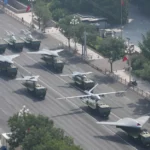Germany’s defense industry is responding to the growing threat of small unmanned aerial systems (sUAS) and loitering munitions with a new cost-effective solution. Quantum Systems has unveiled the “Jäger” interceptor drone—a compact, AI-enabled UAV designed to autonomously detect and neutralize fast-moving aerial threats such as FPV drones and kamikaze UAVs. The system aims to fill a critical gap in short-range air defense (SHORAD) by offering a scalable and affordable countermeasure for both military and strategic infrastructure protection.
Jäger Drone Concept: Autonomous Interception at Low Cost
The Jäger (“Hunter” in German) is a lightweight quadcopter-style interceptor drone developed by Munich-based Quantum Systems. It is designed specifically for short-range interception of hostile drones operating at low altitudes—typically below 500 meters—and at ranges up to several kilometers. The platform is intended to be deployed in swarms or clusters to provide overlapping coverage of critical areas such as forward operating bases (FOBs), mobile command posts, or energy infrastructure.
Unlike traditional SHORAD systems that rely on expensive missiles or radar-guided guns, the Jäger leverages onboard sensors and artificial intelligence (AI) to autonomously detect, classify, pursue, and physically collide with hostile drones. This kinetic kill approach avoids reliance on RF jamming or GPS spoofing—methods that may be ineffective against autonomous or hardened targets.
- Role: Short-range interceptor against sUAS/FPV threats
- Guidance: AI-based visual recognition & onboard autonomy
- Kill method: Kinetic collision (hard-kill)
- Cost per unit: Estimated under €10,000
- Deployment: Man-portable launcher or vehicle-mounted pod
Tactical Need Driven by Ukraine War Lessons
The development of the Jäger system reflects operational lessons from the ongoing war in Ukraine. There, both Russian and Ukrainian forces have used thousands of low-cost FPV drones—often modified commercial quadcopters—for reconnaissance and strike missions. These systems are difficult to detect using traditional radar due to their small radar cross-section (RCS) and low flight profiles.
The German Bundeswehr has recognized that its current air defense architecture lacks sufficient capability against these proliferating threats. While systems like Oerlikon Skynex or IRIS-T SLM provide medium-to-high altitude coverage with radar-guided interceptors or missiles costing hundreds of thousands per shot, they are economically unsustainable when facing swarms of €500 FPV drones.
This cost asymmetry has driven NATO members—including Germany—to explore layered C-UAS architectures that combine radar detection with electro-optical tracking and low-cost interceptors like Jäger at the tactical edge.
Technical Features: Autonomy-First Design
The Jäger drone incorporates several key technical features aimed at enabling fully autonomous interception without human-in-the-loop control:
- Sensors: EO/IR cameras with onboard image processing for target detection
- AI Engine: Neural network trained on diverse drone signatures for classification
- Flight Control: GNSS-denied navigation using visual odometry & inertial sensors
- Kinetic Kill Mechanism: Hardened frame designed for high-speed ramming impact
- Swarm Coordination: Mesh networking allows multiple interceptors to coordinate coverage zones autonomously
This autonomy-first approach minimizes operator workload while enabling rapid reaction times—crucial when defending against fast-moving FPV drones traveling at speeds over 100 km/h.
C-UAS Integration Potential Within Bundeswehr Doctrine
The German Ministry of Defence has not yet formally adopted the Jäger system but is reportedly evaluating it under rapid capability acquisition programs aimed at enhancing counter-UAS capabilities across all branches. The Bundeswehr’s Future Combat Air System (FCAS) roadmap includes provisions for integrating manned-unmanned teaming (MUM-T), sensor fusion across echelons, and distributed C4ISR nodes—all areas where autonomous interceptors could play a role.
If adopted, the Jäger could be integrated into existing mobile SHORAD units alongside Rheinmetall’s Skyranger turret or Diehl Defence’s IRIS-T SLS launchers. Alternatively, they could be deployed independently around fixed installations using containerized launch-and-recharge stations similar to those used by Israel’s Drone Dome system.
A Growing Market for Autonomous Interceptors
The emergence of systems like Quantum Systems’ Jäger reflects a broader trend toward low-cost autonomous hard-kill solutions in the global counter-UAS market. Similar concepts are being pursued by other firms including Anduril Industries’ Anvil interceptor in the U.S., Elbit’s Lanius loitering munition in Israel, and China’s various kamikaze quadcopters developed under state programs.
This market segment is expected to grow rapidly as militaries seek scalable defenses against increasingly sophisticated but inexpensive aerial threats. According to research firm MarketsandMarkets™, the global C-UAS market is projected to exceed $6 billion by 2027—with hard-kill solutions comprising a growing share due to limitations of soft-kill methods alone.
Conclusion: From Prototype to Battlefield?
The success of Quantum Systems’ Jäger will depend on real-world testing results and procurement decisions over the next two years. If it proves reliable under battlefield conditions—and can maintain its sub-€10k price point—it may become a key component in Germany’s evolving layered air defense strategy.
The increasing ubiquity of sUAS threats has made traditional SHORAD architectures obsolete without augmentation from AI-driven micro-interceptors like Jäger. As NATO forces modernize their defensive postures around forward-deployed units and critical infrastructure nodes alike, such technologies may soon become standard kit across European battle groups.










